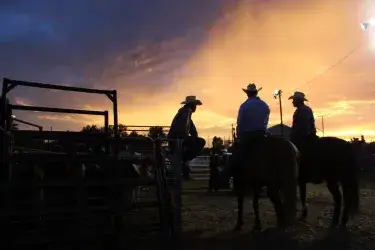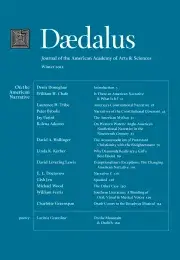
Is There an American Narrative & What Is It?
Nearly four centuries of American history have witnessed the evolving conflict between two competing sets of values: a belief that acting on behalf of the common good should guide social and political behavior, and a belief that unfettered individual freedom should dominate political and social life. Tracing this conflict from Puritanism through the American Revolution, the Civil War, the rise of industrialism, the Progressive Era, the New Deal, the Great Society, and the conservative revival of the Nixon/Reagan era, the essay reveals this clash of values as pivotal to understanding the narrative of American history, with contemporary political battles crystallizing just how basic this conflict has been.
America’s Constitutional Narrative
America has always been a wonderfully diverse place, a country where billions of stories spanning centuries and continents converge under the rubric of a Constitution that unites them in an ongoing narrative of national self-creation. Rather than rehearse familiar debates over what our Constitution means, this essay explores what the Constitution does. It treats the Constitution as a verb – a creative and contested practice that yields a trans-generational conversation about the meaning of our past, the imperatives of our present, and the values and aspirations that should point us toward our future. And it meditates on how this practice, drawing deeply on the capacious wellsprings of text and history, simultaneously reinforces the political order and provides a language for challenging its legitimacy, thereby constituting us as “We, the People,” joined in a single project framed centuries ago that nevertheless remains inevitably our own.
Narratives of the Constitutional Covenant
The constitutional narrative plays perhaps a surprisingly important role in American society. It claims to unfold present judgment from past precedent, according to the doctrine of stare decisis, given an eloquent exposition by the Supreme Court in Planned Parenthood of Southeastern Pennsylvania v. Casey, where the Constitution is referred to as a “covenant” among generations. Analysis of this and other covenantal narratives spun by the Court suggests that despite the emphasis on precedent they may work according to the retrospective logic of narrative itself, in which elements become functional in terms of what follows them. Plots work from end to beginning, reinterpreting the past in terms of the present. The Supreme Court opinion, when subjected to an analysis sensitive to its narrative rhetoric, suggests something akin to the structure of prophecy and fulfillment in its composition of the covenantal narrative.
The American Mythos
This essay examines the notion of an American narrative, looking at a variety of myths that have been prominent and that have, in various ways, shaped the concept of a nation devoted to Enlightenment and Anglo-Saxon ideals. These include liberty, equality, and justice, which can be traced to thinkers such as Montesquieu, as well as ideals laid out in the Magna Carta.
On Western Waters: Anglo-American Nonfictional Narrative in the Nineteenth Century
Anglo-American westward expansion provided a major impulse to the development of the young United States’ narrative tradition. Early U.S. writers also looked to the South, that is, to the Spanish New World and, in some cases, to Spain itself.
The Accommodation of Protestant Christianity with the Enlightenment
Throughout its history, the United States has been a major site for the accommodation of Protestant Christianity with the Enlightenment. This accommodation has been driven by two closely related but distinct processes: the demystification of religion's cognitive claims by scientific advances, exemplified by the Higher Criticism in Biblical scholarship and the Darwinian revolution in natural history; and the demographic diversification of society, placing Protestants in the increasingly intimate company of Americans who did not share a Protestant past and thus inspiring doubts about the validity of inherited ideas and practices for the entire human species.
Why Diamonds Really are a Girl’s Best Friend
The old law of domestic relations and the system known as coverture have shaped marriage practices in the United States and have limited women’s membership in the constitutional community. This system of law predates the Revolution, but it lingers in U.S. legal tradition even today. After describing coverture and the old law of domestic relations, this essay considers how the received narrative of women’s place in U.S. history often obscures the story of women’s and men’s efforts to overthrow this oppressive regime, and also the story of the continuing efforts of men and some women to stabilize and protect it.
Exceptionalism’s Exceptions: The Changing American Narrative
Seven years after 9/11, the American way of life was again shaken to its foundation by the Great Recession of 2008. The logic of an unregulated market economy produced its predetermined result. The American middle class, the historic protagonist of the American narrative, became an endangered species.
The Other Case
This essay explores the suggestion that many American narratives are supplementary, correcting narratives–alternatives to the main story on offer. The guiding thought is that of Henry James’s “possible other case,” and the chief example is Cormac McCarthy’s “No Country for Old Men,” in which one story after another fails to cope with the ongoing mystery it faces.
Southern Literature: A Blending of Oral, Visual & Musical Voices
The blending of oral traditions, visual arts, and music has influenced how Southern writers shape their region’s narrative voice. In the South, writing and storytelling intersect. Mark Twain introduced readers to these storytellers in “Adventures of Huckleberry Finn.” Twain blends both black and white voices within Huck's consciousness and awareness – in Huck’s speech and thoughts – and in his dialogues with Jim.
Death Comes to the Broadway Musical
The Broadway musical is an excellent prism for viewing the narrative of American life – as it is, has been, and perhaps should be. In the first part of the twentieth century, musicals viewed life through rose-colored glasses; musicals were equivalent to musical comedy. Starting in the 1940s, the mood of musicals darkened.
